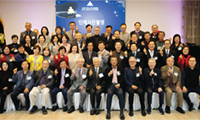▶ Beijing’s strict quarantines may have saved lives.
CHANGGANG, China - Few farmers in this southern village gave much thought to the epidemic that had begun spreading rapidly in the United States early this summer until the authorities sealed its 100 residents off from the outside world for about a week. It turned out that a visitor from California had shown symptoms of the swine flu virus, or H1N1, when he arrived for a funeral.
Quarantines and medical detentions are among the aggressive measures that Chinese officials have taken to slow the transmission of H1N1, which quickly spread worldwide after being diagnosed first in North America.
To protests from around the world, China isolated entire planeloads of people entering the country if anyone on the plane exhibited flulike symptoms. Local authorities canceled school classes at the slightest hint of the disease and ordered students and teachers to stay home. China was virtually alone in taking such harsh measures.
Now, Chinese and foreign health officials say some of those contested measures - more easily adopted by an authoritarian state - may have helped slow the spread of the disease. China has not had to cope with a crush of cases, and it began administering a vaccine for swine flu in early September, the first country to do so.
Foreign officials also say China demonstrated an unusual openness to sharing information about H1N1 with its citizens and other governments, in contrast to its secretive approach to the near pandemic of severe acute respiratory syndrome, or SARS, a few years ago.
That is not to say China has been spared. On November 10, Health Ministry officials reported an “explosive” growth of H1N1 on the mainland because of the onset of winter, pushing the total number of cases to more than 59,000. At least 30 people have died here after contracting H1N1.
Exact data on the virus is hard to pin down; many more cases are suspected than confirmed, and countries often use different methods to identify cases. Still, the indications in China are much more positive than those in India. Like China, India has more than a billion people, many living in poor, rural conditions, and was exposed to the virus after it had been identified in the West. The Indian Health Ministry has reported 505 deaths.
The United States, where the virus was spreading before it was identified in the spring, has reported more than two million cases and about 4,000 deaths in a population of 300 million.
“I think there were a variety of measures put in place by different countries, and it’s difficult to say what worked best and what didn’t, but China’s has worked very well,” said Dr. Michael O’Leary, the director of the Beijing office of the World Health Organization.
As of August, 56 million people had been screened for flulike symptoms at China’s borders, said Feng Zijian, director of the emergency office of the Chinese Center for Disease Control and Prevention. Mr. Feng said he did not know the number of travelers who had been quarantined. The United States Embassy in Beijing said 2,046 American citizens had been quarantined by the end of October, with 215 testing positive for H1N1.
“If these strict measures had not been taken, and if there had been a sudden outbreak of the disease, there would have been a huge panic among the Chinese population,” Mr. Feng said. “Although there were many criticisms from outside, people should understand China’s considerations.”
But Mr. Feng and Dr. O’Leary also say the social and financial costs of China’s tough measures will have to be evaluated to see whether they were worth the benefits. And it is unclear how decisive those actions were in slowing the transmission of H1N1 - the summer heat in much of China was a critical factor in slowing the spread.
Quarantines of entire school groups from overseas ignited outrage.
In July, a group of 65 students and seven chaperons from St. Mary’s School in Medford, Oregon, was quarantined twice.
“At the time, it seemed extreme, and it seemed restrictive, because I had never experienced an infectious disease outbreak,” said Scott Dewing, director of technology at the school. “Now, looking back and seeing some of the measures that are being taken now in the U.S., the Chinese measures don’t seem so extreme.”
Li Bibo contributed research from Beijing. Keith Bradsher contributed reporting from Hong Kong.
스마터리빙
more [ 건강]
[ 건강]이제 혈관 건강도 챙기자!
[현대해운]우리 눈에 보이지 않기 때문에 혈관 건강을 챙기는 것은 결코 쉽지 않은데요. 여러분은 혈관 건강을 유지하기 위해 어떤 노력을 하시나요?
 [ 건강]
[ 건강]내 몸이 건강해지는 과일궁합
 [ 라이프]
[ 라이프]벌레야 물럿거라! 천연 해충제 만들기
 [ 건강]
[ 건강]혈압 낮추는데 좋은 식품
[현대해운]혈관 건강은 주로 노화가 진행되면서 지켜야 할 문제라고 인식되어 왔습니다. 최근 생활 패턴과 식생활의 변화로 혈관의 노화 진행이 빨라지고
사람·사람들
more
[송년행사 화보] “이웃과 함께 나누고 지인과 함께하니 행복”
KYCC13일 윌튼 플레이스 초등학교에서 열린 ‘한인타운청소년회관(KYCC) 홀리데이 카니발’이 성황리에 막을 내렸다. 올해는 KYCC 창립 …

[송년행사 화보] “ ‘손에 손잡고’ 한 해 마무리… 건강과 행복 기원”
전주고·북중남가주 전주고·북중 총동창회(회장 백규종)의 2025년 정기총회 및 송년회가 지난 14일 LA 작가의 집에서 성황리에 열렸다. 이날…
[송년행사 화보] “한 해를 마무리하며… 화기애애…
LA 러너스클럽LA 러너스클럽(회장 김두병)은 13일 작가의 집에서 80여명의 회원과 가족이 참석한 가운데 송년회를 마쳤다. 2007년 창립된…
[송년행사 화보] “웃음과 감사 가득 ‘훈훈’… …
한국학교총연합회미주한국학교총연합회(회장 이영숙)가 주최한 제43회 장기 근속교사 포상 및 송년의 밤 행사가 140여명의 교사들이 참석한 가운데…
[송년행사 화보] “친구야 반갑다… 선배님들 모두…
경남중고경남중·고등학교 남가주 동창회(회장 예해덕)는 지난 6일 송년회를 열고 동문 및 가족 60여 명이 참석한 가운데 끈끈한 우정을 확인했다…
많이 본 기사
- LA산불 여파 ‘심각’ 지역 주민 건강악화
- 크리스마스 연휴 겨울폭풍 남가주 연안 2~4인치 비
- 브라운대 한인학생, 총격참사 극적 생존
- 미 북서부는 홍수, 동부는 폭설 사태 비상
- LA 소파이 스테디엄 8경기 확정
- 일본도 핵잠 도입 논의 본격화? 방위장관 미 해군기지 핵잠 시찰
- 치솟는 원·달러 환율… 1,480원대 찍어
- 중고차 주행거리 조작 ‘주의보’
- ‘우크라 전쟁 피해배상’ 국제기구 만든다
- 트럼프, 베네수엘라 정권 ‘테러 단체’ 지정
- ‘브라운대 총기참사’ 뉴욕 한인학생도 총상
- [윌셔에서] 잠시 멈추어 서서
- 시드니 총기난사범, 인도 출신 이민자
- 박나래 빠진 ‘나혼산’ 촬영 현장 어땠나.. “웃음 보장 100% 조합”
- 뉴욕주 안락사 합법화 초읽기 호쿨, “안전장치 마련되면 서명”
- 에어 프레미아 취항, 기대 컸나
- ‘돈봉투 수수’ 민주당 전현직 의원들 2심 무죄…1심 뒤집혀
- ‘천의 얼굴’ 루푸스… “젊은 여성, 이유 없는 발진·탈모 있으면 의심해야”
- 트럼프 “내년봄 최대규모 세금환급…군… 2
- ‘항염증 식단’ 정답은 균형… 전체적 패턴이 중요
- VA 한인 2세, 드라마 주연 맡아
- 월드컵 방문객 ‘미국행’… 한국선 ESTA(전자 여행 허가서)로 입국 가능
- “AI 활용 한국어 수업, 선택 아닌 필수”
- 비트코인, 역대 네번째 연간 하락세
- 내년에 집 팔려면, 어떤 준비가 필요할까?
- 강경화 주미대사 신임장 제정 트럼프, 이 대통령 안부 물어
- “판공비 1만달러 전액 반환하겠다”
- 백악관 역대 대통령 사진에 악플 단 … 2
- 뉴욕한인 팔레스타인 활동가 체포
- 팰팍 최대규모 주상복합단지 들어서나 1
- “야, 매운맛 좀 보자”..차승원·추성훈, ‘15년 우정’의 ‘차가네’
- 뱅크오브호프, 규모도 1위·봉사활동도 ‘으뜸’
- “신뢰감 있는 이미지”..김도훈, 광고계 러브콜 쇄도
- [수잔 최 변호사의 LIFE &] AI 시대 편리함에 안주하지 말자
- 박찬욱 ‘어쩔수가없다’, 아카데미 예비후보
- [여명] 금붕어를 키우는 오지선다형 수능
- VA·MD 등 21개주, 우버 상대 소송 제기
- [로터리] 지멘스가 만드는 미래 동네
- 5년 규칙은 옛말… 집 사고 10년은 보유해야 본전
- 테슬라, 자율주행 과장광고 적발
- “동지 팥죽도 드시고 달력도 받아가세요”
- 유급 가족병가, 15명 이상 사업체로 확대
- 워런 버핏의 투자자 위한 핵심 조언은
- 올림퍼스스파 2만달러…불우이웃돕기성금 쇄도...현재까지 3만달러 넘어…장철호ㆍ서울대ㆍ시산회ㆍ최병택씨 기탁
- 상습적 아동 성추행 치어리딩 코치 유죄
- 김유정, 이번엔 귀신이다.. ‘복수귀’서 박지환→조여정과 호흡
- 자폐 어린이 돕기 ‘신년 나눔 음악회’
- “트럼프 경제 지지도 36%…집권 1·2기 통틀어 최저치”
- 한인상공회의소 ‘A 성적표’ 받았다...힘들게 출발했지만 그랜트 등 적지 않은 노력과 결실로 2년 임기 마쳐
- “사고 직후 대응이 보상 좌우한다”
1/5지식톡

-
 ☝️해외에서도 가능한 한국어 선생님…
0
☝️해외에서도 가능한 한국어 선생님…
0이 영상 하나면 충분합니다!♥️상담신청문의♥️☝️ 문의 폭주로 '선착순 상담'만 진행합니다.☎️ : 02-6213-9094✨카카오톡ID : @GOODEDU77 (@골뱅이 꼭 붙여주셔야합니다…
-
 테슬라 자동차 시트커버 장착
0
테슬라 자동차 시트커버 장착
0테슬라 시트커버, 사놓고 아직 못 씌우셨죠?장착이 생각보다 쉽지 않습니다.20년 경력 전문가에게 맡기세요 — 깔끔하고 딱 맞게 장착해드립니다!장착비용:앞좌석: $40뒷좌석: $60앞·뒷좌석 …
-
 식당용 부탄가스
0
식당용 부탄가스
0식당용 부탄가스 홀세일 합니다 로스앤젤레스 다운타운 픽업 가능 안녕 하세요?강아지 & 고양이 모든 애완동물 / 반려동물 식품 & 모든 애완동물/반려동물 관련 제품들 전문적으로 홀세일/취급하는 회사 입니다 100% …
-
 ACSL 국제 컴퓨터 과학 대회, …
0
ACSL 국제 컴퓨터 과학 대회, …
0웹사이트 : www.eduspot.co.kr 카카오톡 상담하기 : https://pf.kakao.com/_BEQWxb블로그 : https://blog.naver.com/eduspotmain안녕하세요, 에듀스팟입니다…
-
 바디프렌드 안마의자 창고 리퍼브 세…
0
바디프렌드 안마의자 창고 리퍼브 세…
0거의 새제품급 리퍼브 안마의자 대방출 한다고 합니다!8월 23일(토)…24일(일) 단 이틀!특가 판매가Famille: $500 ~ $1,000Falcon: $1,500 ~ $2,500픽업 & 배송직접 픽업 가능LA…
케이타운 1번가
오피니언
 수잔 최 한미가정상담소 이사장 가정법 전문 변호사
수잔 최 한미가정상담소 이사장 가정법 전문 변호사 [수잔 최 변호사의 LIFE &] AI 시대 편리함에 안주하지 말자
 김도년 성균관대 건축학과 교수 스마트도시·건축학회장
김도년 성균관대 건축학과 교수 스마트도시·건축학회장 [로터리] 지멘스가 만드는 미래 동네

[여명] 금붕어를 키우는 오지선다형 수능
 허경옥 수필가
허경옥 수필가 [윌셔에서] 잠시 멈추어 서서
 양홍주 / 한국일보 논설위원
양홍주 / 한국일보 논설위원[지평선] 판다 없는 일본

[왈가 왈부] 쿠팡 김범석 “글로벌 CEO라 불출석”… ‘맹탕’ 청문회 불보듯
 정숙희 논설위원
정숙희 논설위원칠레에서 영국까지, 27년을 걷다
 마크 A. 시쎈 / 워싱턴포스트 칼럼니스트
마크 A. 시쎈 / 워싱턴포스트 칼럼니스트 [마크 A. 시쎈 칼럼] MAGA와 ‘힘에 바탕한 외교정책’
 김동찬 시민참여센터 대표
김동찬 시민참여센터 대표 [미국은 지금] 위기의 시대, 사회안전망은 최후의 방어선이다
1/3지사별 뉴스

‘브라운대 총기참사’ 뉴욕 한인학생도 총상
▶총상 입은 상황서도 동료학생 의식 잃지않도록 도와 ▶부친도 동문 “우리 가족에게 고통스러운 일”지난 13일 발생한 브라운대학교 총기난사(본보…
뉴욕주 안락사 합법화 초읽기 호쿨, “안전장치 마련되면 서명”

에어 프레미아 취항, 기대 컸나
에어 프레미아의 워싱턴 덜레스 국제공항과 인천국제공항간 취항이 확정된 가운데(본보 15일자 A1면), 에어 프레미아 항공권 가격이 당초 기대에…
VA·MD 등 21개주, 우버 상대 소송 제기

베이지역 스포츠팀, SF 한인회에 후원금
샌프란시스코 베이지역 한인회(회장 김한일)는 한인 메이저리거 이정후 선수의 소속팀인 샌프란시스코 자이언츠(San Francisco Giants…
불자커뮤니티 20일 청소년발표회및 송년회

오늘 하루 이 창 열지 않음 닫기 




















































.png)


댓글 안에 당신의 성숙함도 담아 주세요.
'오늘의 한마디'는 기사에 대하여 자신의 생각을 말하고 남의 생각을 들으며 서로 다양한 의견을 나누는 공간입니다. 그러나 간혹 불건전한 내용을 올리시는 분들이 계셔서 건전한 인터넷문화 정착을 위해 아래와 같은 운영원칙을 적용합니다.
자체 모니터링을 통해 아래에 해당하는 내용이 포함된 댓글이 발견되면 예고없이 삭제 조치를 하겠습니다.
불건전한 댓글을 올리거나, 이름에 비속어 및 상대방의 불쾌감을 주는 단어를 사용, 유명인 또는 특정 일반인을 사칭하는 경우 이용에 대한 차단 제재를 받을 수 있습니다. 차단될 경우, 일주일간 댓글을 달수 없게 됩니다.
명예훼손, 개인정보 유출, 욕설 등 법률에 위반되는 댓글은 관계 법령에 의거 민형사상 처벌을 받을 수 있으니 이용에 주의를 부탁드립니다.
Close
x